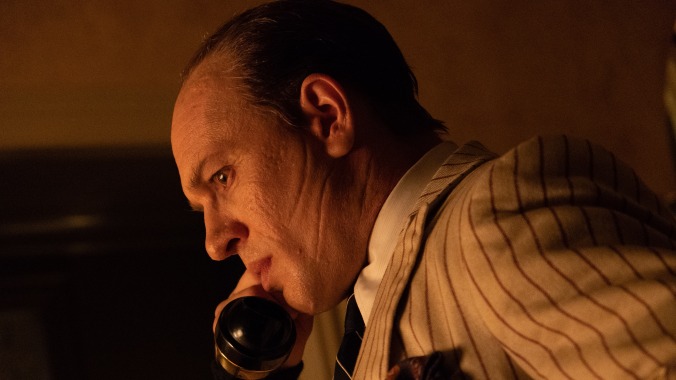Tom Hardy plays a fading Capone in a baroque portrait of the gangster's decline


It was probably inevitable that Tom Hardy—that stocky English bulldog of a movie star—would one day slip into the slick wardrobe, blemished skin, and vicious disposition of Al Capone. (Hardy has, like Robert De Niro before him, played his share of real criminals, those roles leading like a trail of bodies to the most notorious of them all.) Yet the Capone that stumbles through nearly every scene of Josh Trank’s baroque postscript of true-crime drama is no longer the Chicago kingpin of headline infamy. His gait rigid, skin spongy with patches of red rash, and voice an indecipherable croak, Fonzo (as everyone calls him) is a shell of himself, withering in premature decay: a fortysomething man with the frail, failing body of someone much older, even as his mind regresses to that of someone much younger. Hardy, in other words, hasn’t been cast for his malleably imposing physique so much as his willingness to diminish it. He looks both big and small, conveying the physicality of someone used to looming over everyone—dwarfing them with the enormousness of his body and enormity of his reputation—who’s now found himself shrinking by the day.
Capone joins a growing list of biographical dramas, like The Happy Prince and Judy, that chronicle only the ignoble final days of their subjects. The film is set in the late 1940s, after Capone’s eight-year prison sentence for tax evasion, and almost entirely within the opulent Florida estate where he spent the remainder of his life, under the care of his ceaselessly loyal wife, Mae (Linda Cardellini). He was, at that point, suffering from severe symptoms of untreated syphilis; his mind and body declining in tandem alongside his disappearing empire, fortune, and pawned belongings. Capone, as we meet him, lives in a fugue state of confusion and paranoia—he’s like the Charles Foster Kane of over-the-hill mobsters, wasting away in luxury. But not all of his problems are in his head: The feds are watching him, hoping to dig up something more damning than the financial crimes for which he served so little time.
This is nothing close to a comprehensive biopic, which is a relief, in theory. There are no flashbacks to the Windy City and little in the way of exposition; besides the crackle of a radio play dramatizing the Saint Valentine’s Day Massacre, Capone’s life of crime remains unrecounted, its exploits presumed known. In Capone, history asserts itself through ghosts and visions, like a traipse into the ballroom of the glamorous prohibition era—shades of The Shining there—and appearances by an old colleague (Matt Dillon), a composite of various men violently scratched off the boss’ accomplice list. What’s real or not isn’t always clear, because the movie sometimes unfolds from the cloudy perspective of its mentally adrift subject. One might naturally think of The Irishman and its own depiction of time catching up to a fixture of organized crime. But Capone almost plays like a rebuttal to those who insisted Scorsese’s film was too damn long: There’s less power to seeing the pathetic final stretch of a life without the context of everything that came before.
Perhaps the story of someone plummeting from his perch atop the world holds some personal meaning to the writer, director, and editor, who experienced a downfall of his own after the very public, career-torpedoing disaster of making that much maligned Fantastic Four movie. Yet there’s only so much actual drama Trank can wring from these last days, given just how much dementia had overtaken Capone’s mind. If he can barely remember his sins, how can he confront them? Capone ends up mostly emphasizing the corporeal indignities and ironies of his decline: the mighty Scarface puking into a trashcan, loudly shitting his pants during a useless FBI interrogation, and—after a stroke pushes him even further from his heyday fearsomeness—chewing on carrots like a ridiculous cartoon parody of his stogie-chomping self. It’s all the violence of his past revisited upon him through time and disease. (Trank, one might presume, is a David Cronenberg fan, given the amount of body horror he’s now slipped into both the superhero- and gangster-movie genres.)
The FBI’s obsession with monitoring Capone during his last few years might have sprung, on some level, from a cultural exasperation—the public sense that this outsized monster got off way too easy for his years of unspeakable transgression. Capone presents the man’s health problems as a different sort of comeuppance: a reckoning of the mind and body, though not necessarily of the soul. But that doesn’t leave Hardy terribly much to do but dismantle his intimidating presence; it’s a commanding physical performance in search of a richer characterization, of any sense of who Capone was. Somewhere in the middle, his Fonzo stumbles into the bathroom and catches a glimmer of his old, healthy self in the mirror, still looking like a terrifying king among crooks. Maybe Hardy will one day get to play that version of the infamous crime baron. Technology should make that possible, even after he passes the age when the actual Capone couldn’t play the role any longer.